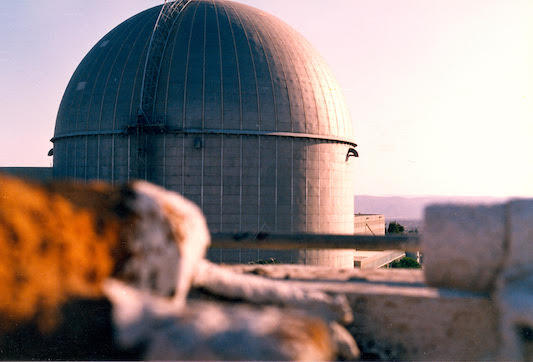 The chemical processes that human kind has been familiar with and managed from the use of fire hundreds of thousands of years ago to the processes around food that emerged with the establishment of settled agrarian societies some 8000 years ago in the Middle East still dominate our understanding of energy. It has been barely a hundred years since it began slowly to be realized that the energy that can be released from nuclear reactions was vastly greater than what all prior human experience and imagination had understood as possible.
The chemical processes that human kind has been familiar with and managed from the use of fire hundreds of thousands of years ago to the processes around food that emerged with the establishment of settled agrarian societies some 8000 years ago in the Middle East still dominate our understanding of energy. It has been barely a hundred years since it began slowly to be realized that the energy that can be released from nuclear reactions was vastly greater than what all prior human experience and imagination had understood as possible.
In 1903, soon after having provided together with Ernest Rutherford the first scientific explanation for radioactivity, Frederick Soddy warned: "The man who put his hand on the lever by which a parsimonious nature regulates so jealously the output of this store of [atomic] energy would possess a weapon by which he could destroy the Earth if he chose." Since then, it has become clear just how short is Soddy's lever, with even single relatively small nuclear facilities capable of doing enormous harm, intentionally or by accident. This issue of Science & Global Security has two articles that explore some consequences of civilian and military nuclear reactors in the Middle East today.
In "Risks to Persian Gulf Cities from Spent Fuel Fires at the Barakah and Bushehr Nuclear Power Plants", Thomas Spence and Ali Ahmad assess the public health, water, and food security impacts of radioactivity exposure of populations and land (water and soil contamination) from cesium-137 releases from the only two operating nuclear power plants in the Middle East. The article models the release, transport, and deposition of cesium-137 from a spent fuel fire in one of the pools at the Barakah nuclear power reactor in the United Arab Emirates and also for a pool at Iran's Bushehr nuclear reactor site - both plants have elevated spent fuel pools, and an accident or an attack could cause the water they hold to cool the spent fuel to leak out, uncovering the spent fuel, allowing it to overheat and triggering a spent fuel fire. This work builds on earlier studies published in this journal [Robert Alvarez et al., "Reducing the Hazards from Stored Spent Power-Reactor Fuel in the United States," Science & Global Security, 11, no. 1, (2003); Jan Beyea et al., "Damages from a Major Release of 137Cs into the Atmosphere of the United States," Science & Global Security, 12, no. 1-2, (2004); Frank N. von Hippel, Michael Schoeppner, "Reducing the Danger from Fires in Spent Fuel Pools," Science & Global Security 24, no. 3 (2016)].
Spence and Ali Ahmad assess the results from cesium-137 release, atmospheric transport and deposition simulations that were run for every day since 2010 to assess the variation and outcomes. The findings suggest that in some cases major cities in and around the Persian Gulf region (including in Bahrain, Kuwait, Qatar, Iran, Iraq, and Saudi Arabia) could be affected severely enough to require forced relocation of people from these cities, with attendant grave economic and social impacts for the whole region. The results pose a serious question for the further expansion of nuclear power in the Middle East and the authors argue for ending the use of nuclear energy in the Middle East, and interim measures to reduce the risks from current spent fuel management activities, including the urgent transfer of spent fuel from pools into safer dry cask storage.
In "Plutonium and Tritium Production in Israel's Dimona Reactor, 1964-2020," [FREE PDF] Alexander Glaser and Julien de Troullioud de Lanversin explore the operational history of the only military nuclear reactor in the Middle East, Israel's Dimona reactor. This relatively low-powered, initially about 40 MW, plutonium production reactor and the associated reprocessing plant was provided by France in the late 1950s, and satellite imagery shows it still operating in early 2021. The analysis relies on neutronics calculations informed by U.S. declassified information on Dimona reactor design as well as reprocessing plant operational details revealed by Mordechai Vanunu, a whistleblower who worked at Dimona for almost a decade.
The article proposes a Dimona operating history from 1964 to 2020 with three distinct phases, each with a distinct combination of reactor fuel characteristics, fuel enrichment and reactor power, and concludes that as of December 2020, Dimona had produced 830 ± 100 kg of plutonium. This plutonium is enough for about 150-190 nuclear warheads, assuming them to be compact two-stage thermonuclear nuclear weapons, far more than accepted independent estimates of an Israeli arsenal of 80-85 nuclear weapons. This suggests Israel has a large stockpile of plutonium it holds in reserve and that it could build a much larger arsenal. An arsenal of 150 nuclear weapons would be enough to destroy every city in the Middle East with a population over 250,000 people.
The analysis also finds that Dimona could make on the order of 50-60 grams of tritium each year to sustain the tritium-boosting used in such weapons to increase the yield of the primary plutonium fission explosive and allow it to efficiently drive the thermonuclear fusion in the secondary explosive. To produce plutonium and tritium at these levels, however, the modeling suggests that Dimona fuel would need to be enriched to about 1.5% uranium-235, and for this Israel would need a modest uranium enrichment capability. The results highlight that a small nuclear reactor, reprocessing plant, and uranium enrichment capacity can sustain a rather large and advanced nuclear arsenal.
